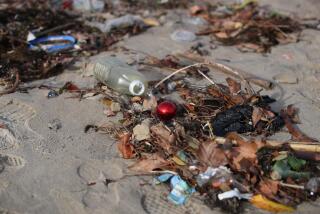McDonald’s to Do Away With Foam Packages
- Share via
The surprise announcement Thursday that McDonald’s would phase out its plastic clamshell packaging represents the first result coming from an unusual joint effort with an environmental group.
McDonald’s has been working with the Environmental Defense Fund--an influential group of lawyers, scientists and economists based in Washington, D.C.--for the past three months looking at all waste questions at the fast-food chain.
“They kept our feet in the fire to look for alternative packaging, alternatives to foam,” said Shelby Yastrow, McDonald’s senior vice president in charge of environmental affairs.
“And we found the alternative and figured out how to make it work.”
“The move really opens the door to further changes,” said Richard Denison, a senior scientist with the environmental group and its task-force spokesman.
McDonald’s is not yet sure just what paper-based packaging will be adopted over the next two months. But the first wave of products to be affected will be the Big Mac, McD.L.T., Quarter Pounder, Egg McMuffin, Filet-O-Fish, Chicken McNuggets, the McChicken Sandwich and the Danish. These use 75% of the company’s foam containers.
The fast-food chain, which has more than 11,000 restaurants around the world, has long been a target of environmental groups critical of what they consider wasteful and ecologically unsound packaging. The Oak Brook, Ill.-based company and its clamshell--often used only for as long as it takes to walk to a table--have been widely condemned as symbols of a throw-away society.
Since forming a task force with McDonald’s, Environmental Defense Fund staffers have studied the composting of food scraps, examined benches made from recycled plastic utensils and generally looked to reduce the amount of packaging at every point.
“They’re working in our restaurants,” Yastrow said, “asking questions like: ‘How about trying to serve the drinks without lids?’ That sort of thing. . . . We have a lot of things we’re working on, but this is the first announcement that has come out from under the door.”
There are hints that the joint venture has had its moments of tension, however.
McDonald’s had defended its polystyrene packaging, noting that unlike cardboard, no trees had to be cut down to produce it and it provides neat, sanitary protection of food. Many defenders also say that polystyrene can be disposed of in waste incinerators or even used again through the small but growing polystyrene recycling system.
“No question, we are disappointed that they made this decision,” said Eric Dezenhall, a spokesman for the National Polystyrene Recycling Co. Its experiments with foam recycling had made McDonald’s “one of the best educational resources in the country,” he said.
The Environmental Defense Fund has long promoted paper and cardboard containers and opposes incinerators.
In the task force agreement, both sides had been wary. The environmental group would not be paid, and McDonald’s cannot use the environmental group’s name for promotion.
For its part, McDonald’s has made no pledge to take the group’s advice to heart if it doesn’t agree with the task force conclusions. The two sides haven’t even agreed to issue a joint report.
“We didn’t turn the management of this company over to a task force,” Yastrow said.
Still, more than a week ago when McDonald’s told the Environmental Defense Fund that it was planning to expand its polystyrene recycling program to all restaurants, the company listened as the environmentalists argued against it, over the phone and in meetings.
“The last four or five or six days around here were very intense, about whether we should make the change,” Yastrow said. The telling argument became that paper packaging would fit into the company’s operations as well as polystyrene, but would reduce package bulk by 90%.
For McDonald’s that was a lot better than recycling, since fully 60% of its packages leave the store and wouldn’t be recycled anyway.
The Environmental Defense Fund apparently made a further point to a company made sensitive to criticism from its customers.
“They added the sense of how this would be perceived in the environmental community,” Yastrow said, “because they have a finger on the pulse there.”
Recently McDonald’s has moved to quiet critics by changing its ways. It now uses napkins and Happy Meal boxes made of recycled fiber, and its McRibs sandwiches come wrapped in recycled newsprint. The company has adopted ambitious recycling programs, particularly in New England and Southern California. And back in the storerooms, it has redesigned boxes for transporting French fries in bulk to reduce the number of boxes needed each day. It has even pledged to buy $100-million worth of recycled materials annually to build its new restaurants.
On Thursday, Ed Rensi, president of McDonald’s U.S. operations, announced that, “although some scientific studies indicate that foam packaging is environmentally sound, our customers just don’t feel good about it. So we’re changing.”
Barry Edwards, field purchasing manager for McDonald’s Corp. for the San Francisco region, expects even his workers will be pleased.
“I think that they got the same reaction from their families, friends and customers that we do,” said Edwards, “that they don’t like that kind of packaging, they just don’t want us to use it.”
More to Read
Inside the business of entertainment
The Wide Shot brings you news, analysis and insights on everything from streaming wars to production — and what it all means for the future.
You may occasionally receive promotional content from the Los Angeles Times.









